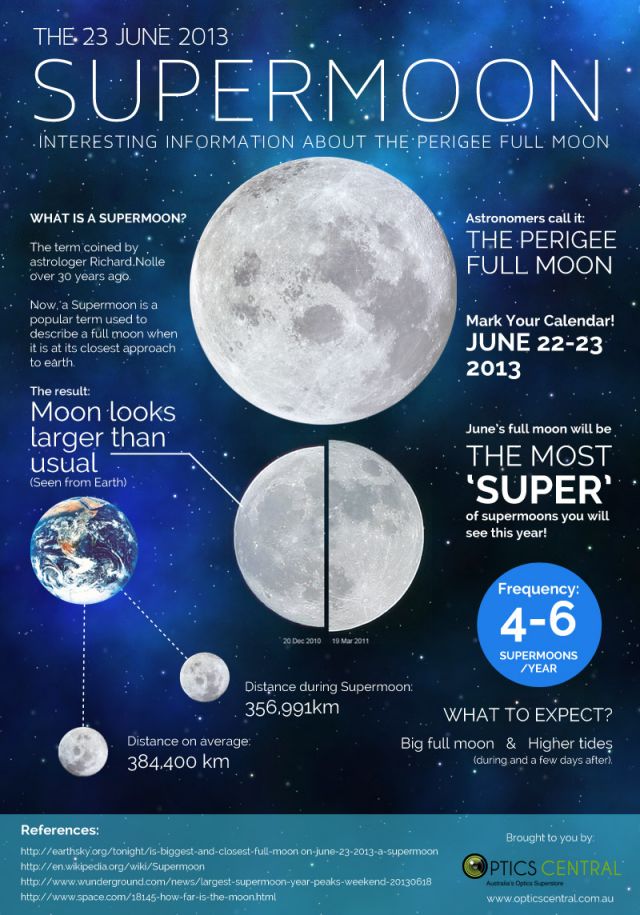This weekend's full moon will be the biggest and brightest of 2013.
Andrew Fazekas
for National Geographic News
This moon, seen from San Pedro de Atacama, Chile, was the largest of 2012. This year's supermoon will occur on June 23, and appear 8 percent larger and 17 percent brighter.
Editor's note: Share your best #supermoon photos with us and our editors may include one in a NationalGeographic.com gallery.
This weekend, skywatchers looking up at the full moon may sense it's a bit more striking than usual—and they won't be imagining it.
On June 23, the moon will be at its closest distance to Earth for 2013 while in its full phase. As a result, it will appear 8 percent larger and 17 percent brighter than usual—an event widely known as a supermoon.
And making it a bit more special, thanks to coincidental timing, this supermoon will be coming on the heels of the June solstice, which takes place only two days before.
Armchair astronomers can also catch the sky show virtually via a live high-definition webcast of the supermoon through SLOOH telescopes in the Canary Islands, off the coast of Africa, starting at 9 p.m. EDT or 6 p.m. PDT on June 23.
The monthly full moon always looks like a big disk, but because its orbit around the Earth is egg-shaped, there are times in the lunar cycle when the moon is at its shortest distance from Earth (called perigee) and times when the moon is at its farthest distance from Earth (called apogee).
Likewise, because the size of the moon's orbit varies slightly, each month's perigee is not always the same distance from Earth.
Two years ago, the so-called supermoon was the closest it's been in two decades—only 356,575 kilometers from Earth.
For this weekend's perigee, the moon will be a tad farther from us at 356,991 kilometers. That's a bit closer than the typical 364,000 kilometers distance, and is set to occur on June 23 at 7:09 a.m. EDT. (The official full moon phase occurs at 7:32 a.m. EDT.)
"The exact moment when the moon is at perigee, it will be overhead in the southern Pacific Ocean," said Anthony Cook, an astronomical observer at Los Angeles's Griffith Observatory. "The western portion of the Americas will see this at sunrise/moonset, while the eastern portion of Asia/Australia will see it at sunset/moonrise."
Super-Effects?
While some are calling it a supermoon, the astronomical community prefers to use the term "perigee full moon."
And they're not exactly rare, since the alignment between the full moon phase with perigee occurs every year, said Adler Planetarium astronomer Mark Hammergen.
But next year's show on August 10, 2014, might be more specular than this one. That's because it's expected to be even closer—clocking in at just 356,896 kilometers from Earth, said Hammergren.
As for a supermoon coinciding with the solstice, that's more unusual.
"This kind of celestial geometry repeats roughly every 14 years," said Hammergren.
And if you thought a supermoon might bring out "super-effects" on Earth, think again. There is no scientific evidence for any connection between a supermoon and natural disasters.
It is, however, well known that tides are highest during new and full moons -- which means if there is a storm surge during a new or full moon, then unusually high coastal flooding may occur.
"When the full or new moon occurs near perigee, there is a slightly stronger effect on the tides," said Hammergren. "There have been coastal floods associated with storms hitting near spring tide at the time of perigee."
Read more http://news.nationalgeographic.com/news/2013/06/130622-supermoon-solstice-biggest-science-space-2013-june/
My Facebook
My Google+
Contact me
miss world vietnam, Miss World. Miss World 2015 is Mireia Lalaguna of Spain! Follow her journey & join us for the countdown to Miss World 2016! Latest pics. What is Miss World?
Subscribe to:
Post Comments (Atom)
Popular Posts
-
Road to Miss International 2011: Nora Viragh (C) was crowned Miss International Hungary 2011 Nora Viragh was crowned the first ev...
-
Miss Perú World 2012 and Miss Perú Universe 2012 Miss Perú World 2012 LIMA, Peru - Giuliana Myriam Zevallos Roncagliolo (23, 1.80m, Lima...
-
Megumi Kagurazaka is a sexy Japanese model who we knew have voluptuous breast, appeared in numerous lingerie photoshoots. Her career started...
-
Road to Miss Universe 2011: >>Vu Hoang My participates in Miss Universe 2011 Check out the latest photos of Vu Thi Hoang My, Mi...
-
* Miss USA 2011 Contestants * Miss USA 2011 - Watch Contestant Voting Clip * Miss USA 2011 - Contestants Photoshoot at the Palms Place Pool ...
-
Road to Miss USA 2012 Miss Kentucky USA 2012, Amanda Mertz Miss Kentucky USA 2012, Amanda Mertz Amanda Mertz was crowned Miss Kentucky USA...
-
Through countless catalogs, magazine covers, calendars and television commercials, Donna DeCianni has captured the hearts of men around the ...
-
By DAILY MAIL REPORTER Yes! Bradley congratulates Scot Gerard on his countryman's win Bradley Cooper might be dating Suki Waterhouse,...











No comments:
Post a Comment